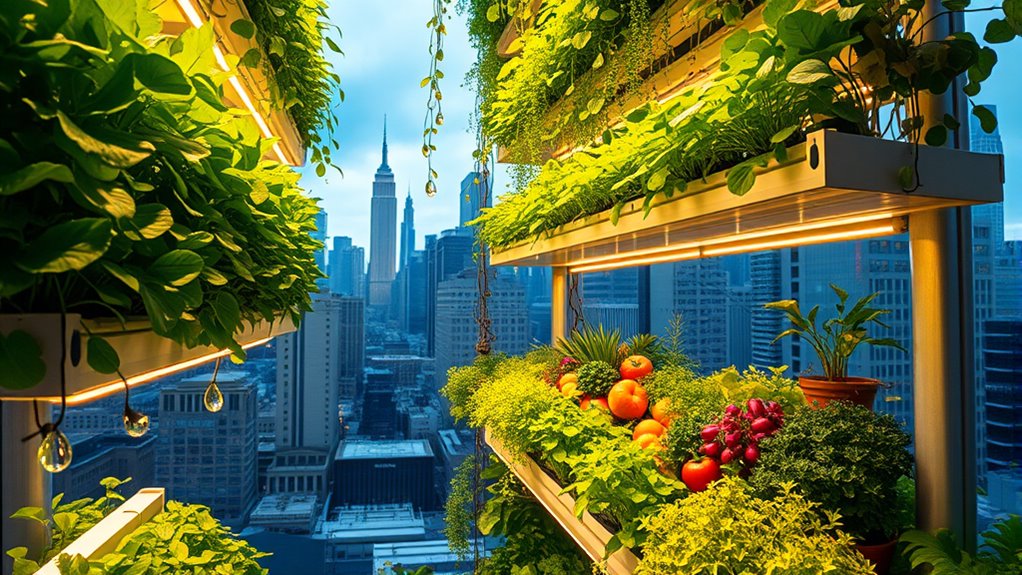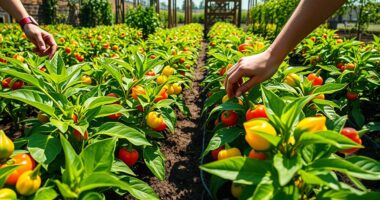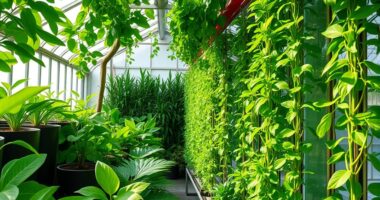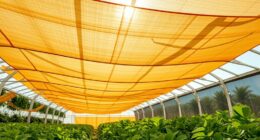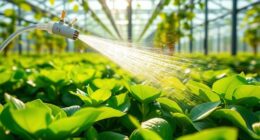If you're looking to transform your urban agriculture game, I've found some fantastic vertical farming solutions! The MARS HYDRO FC1000W LED grow light is highly efficient, while the Vertical Hydroponics Garden Tower accommodates 30 plants in a compact design. You might also consider stackable planters like Mr. Stacky for versatility. With so many options, I'll share more about choosing the best systems and maximizing your space effectively.
Key Takeaways
- Explore LED grow lights like MARS HYDRO FC1000W for efficient light distribution and smart control in vertical farming setups.
- Consider hydroponic systems, such as the Vertical Hydroponics Garden Tower, for compact and automated plant care with significant water savings.
- Utilize soilless farming solutions like net pot holders to promote healthy root development and maximize space efficiency in urban environments.
- Assess initial setup and ongoing costs, including energy and nutrient expenses, to ensure sustainable and budget-friendly vertical farming practices.
- Research literature on sustainable agriculture, such as "The Vertical Farm," to understand the economic benefits and innovations in urban agriculture.
MARS HYDRO FC1000W LED Grow Light with Smart Control Function
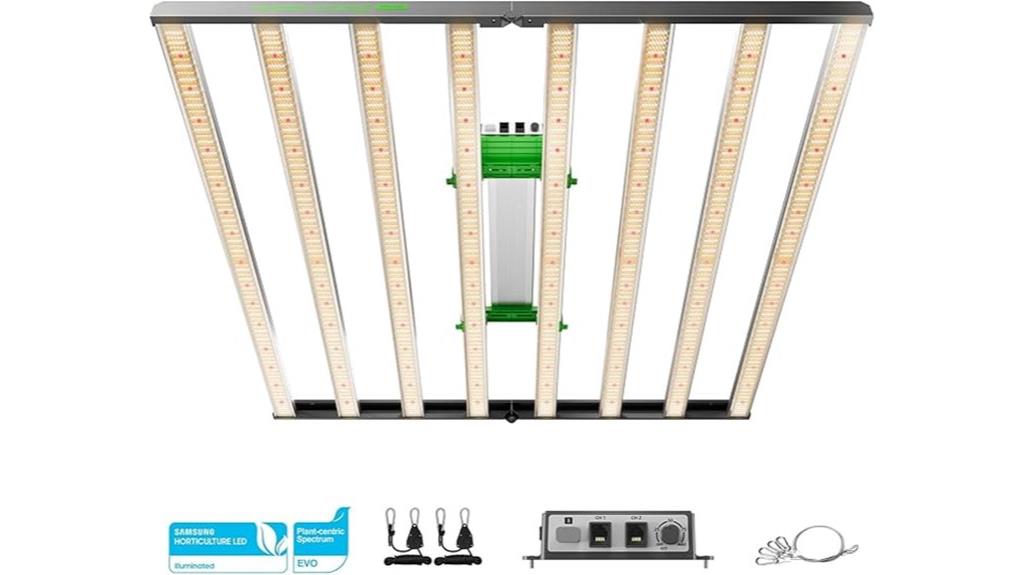
When it comes to vertical farming, the MARS HYDRO FC1000W LED Grow Light with Smart Control Function stands out for its advanced technology, specifically the Samsung LM301H EVO diodes. This light's coverage of 4x4ft or 4x6ft and 1000 watts of power really impressed me. I love the Smart Control Function through the Mars Hydro APP, allowing me to manage the dimmable settings easily. With a remarkable PPFD of up to 3029 μmol/m²/s, it's perfect for all growth phases. The wave-shaped heat sink design guarantees efficient heat dissipation, making my growing experience smoother and more productive.
Best For: The MARS HYDRO FC1000W LED Grow Light is best for both personal and commercial growers looking for efficient and effective lighting solutions for vertical farming.
Pros:
- High Efficiency: Features Samsung LM301H EVO diodes with an overall PPE of 2.9 μmol/j, ensuring optimal growth.
- Smart Control Function: Easily manage light settings through the Mars Hydro APP for a customized growing experience.
- Excellent Light Distribution: The bar-style design promotes even light distribution, reducing hotspots and maximizing plant coverage.
Cons:
- Durability Issues: Some customers report concerns with the durability of the product over time.
- Customer Service: There are mixed experiences regarding the responsiveness of customer service.
- Lower Wattage Concerns: Users caution against using lower wattage models for the flowering phase, which may affect plant yield.
Mr. Stacky 5 Tier Stackable Planter for Indoor/Outdoor Garden

The Mr. Stacky 5 Tier Stackable Planter has transformed my gardening experience. This versatile planter is perfect for growing strawberries, herbs, and flowers, whether indoors or outdoors. Its patented flow-through design conserves water and maximizes space, which I appreciate in my small apartment. Setting it up was a breeze, and I love how lightweight it is for mobility. However, I found that watering from the top sometimes leads to uneven moisture distribution, so I recommend checking each tier. Overall, it's a fantastic choice for anyone looking to enhance their urban gardening game!
Best For: Urban gardeners with limited space looking to grow strawberries, herbs, and flowers indoors or outdoors.
Pros:
- Easy to assemble and lightweight for mobility, making it suitable for small living spaces.
- Patented flow-through design promotes water conservation and efficient use of space.
- Versatile for a variety of plants, particularly those with shallow roots.
Cons:
- Watering from the top can result in uneven moisture distribution across tiers.
- Stability issues may arise in strong winds, requiring additional securing or weighting.
- Some users have reported plant health problems due to watering inconsistencies.
Vertical Gardening: Grow Up, Not Out
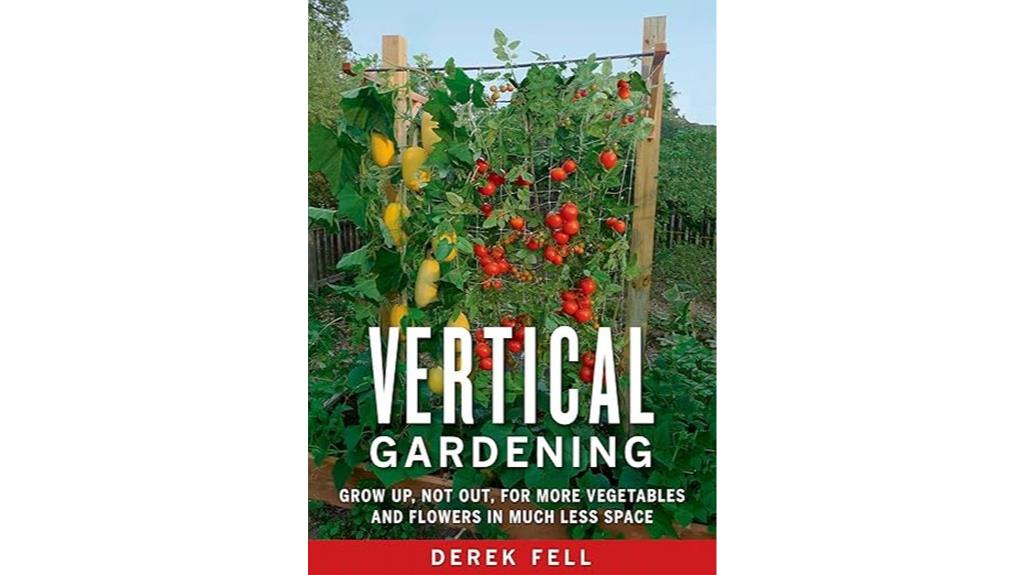
For anyone struggling with limited gardening space, vertical gardening is a game-changer. I've found that growing vertically allows me to maximize my yield considerably. For instance, pole snap beans can yield ten times more than bush beans in a fraction of the space. I love using materials like bamboo to create unique structures, and I've even grown tomatoes above potatoes, making the most of my garden. This method saves water, reduces weeding, and enhances flavor. Whether you're a beginner or seasoned gardener, vertical gardening offers innovative solutions for urban agriculture that anyone can embrace.
Best For: Individuals with limited gardening space looking to maximize yield and efficiency in their gardening practices.
Pros:
- Increased yield: Vertical gardening can produce up to ten times more crops in a smaller footprint compared to traditional methods.
- Water conservation: This method allows for better water management and usage, saving resources.
- Enhanced flavor and plant health: Plants grown vertically tend to have higher chlorophyll content, improving their flavor and overall health.
Cons:
- Learning curve: Beginners may find it challenging to adapt to new techniques and structures.
- Initial setup costs: Creating vertical gardening systems may require investment in materials and infrastructure.
- Potential for pest issues: While easier pest control is possible, vertical systems may still attract pests and require management.
Vertical Hydroponics Garden Tower 30-Plant Growing System
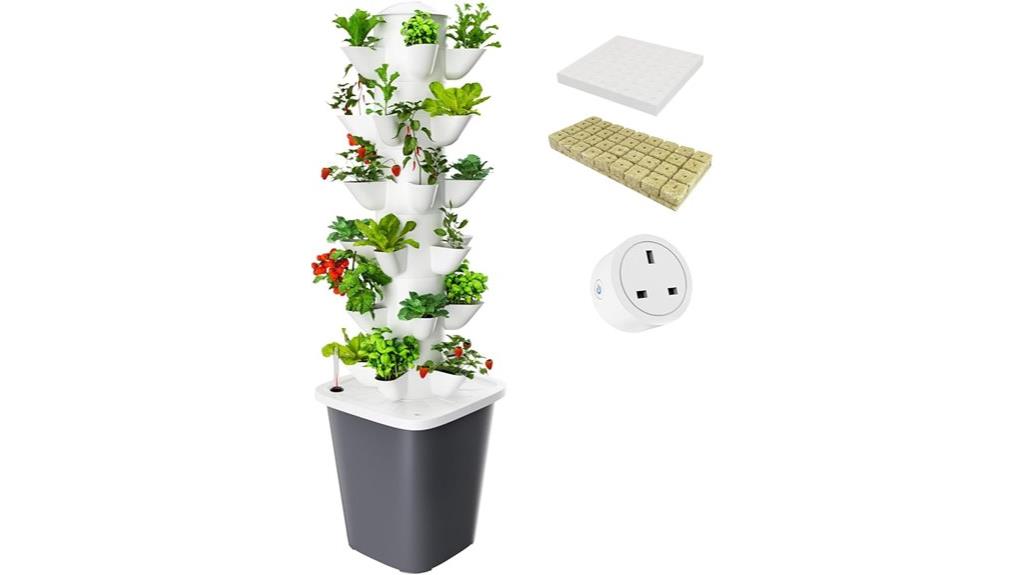
If you're looking to grow a variety of herbs, vegetables, and fruits in limited space, the Vertical Hydroponics Garden Tower 30-Plant Growing System might be your perfect solution. This compact system maximizes your growing area, fitting seamlessly into any apartment. With its automated features and smart timer plug, watering becomes a breeze, leaving you more time to enjoy your fresh harvest. You'll save up to 95% on water, and the food-grade materials guarantee safety for both your plants and family. Plus, it's designed for year-round gardening, so you can enjoy fresh produce no matter the season.
Best For: Urban dwellers and beginners seeking an efficient and space-saving solution for growing herbs, vegetables, and fruits indoors.
Pros:
- Automated watering system and smart timer plug simplify plant care.
- Compact vertical design maximizes growing space in small living areas.
- Saves 90-95% water compared to traditional soil gardening methods.
Cons:
- Some users reported misleading size in product images.
- Occasional complaints about missing pieces or leaks in the system.
- Seeds and plant food are not included, requiring additional purchases.
Vertical Hydroponic Grow Tower for Herbs and Vegetables (15 Layer, 45 Plant Sites)
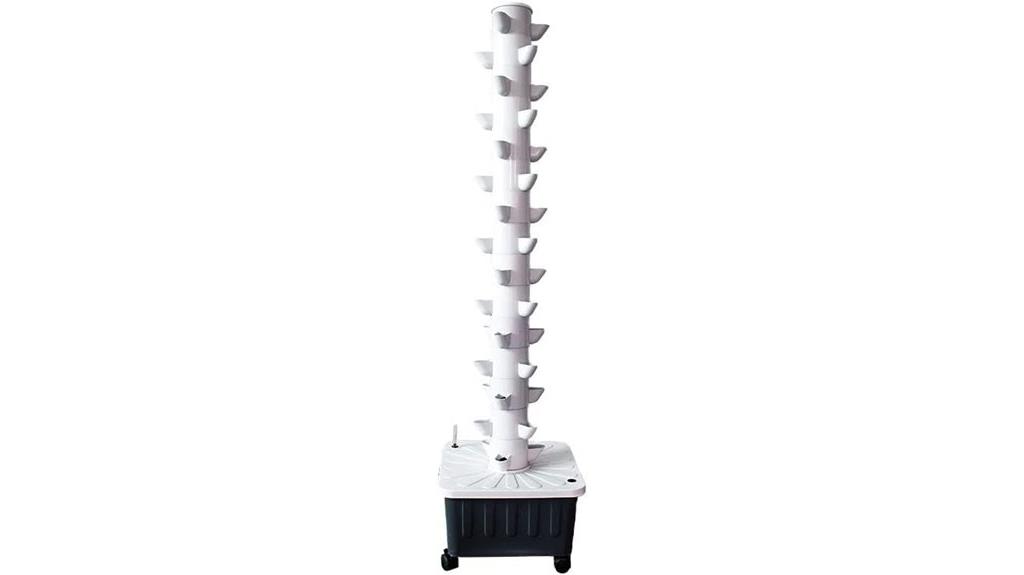
Designed with urban gardeners in mind, the Vertical Hydroponic Grow Tower offers an innovative solution for anyone looking to cultivate herbs and vegetables in limited spaces. With 15 layers and 45 plant sites, it's perfect for maximizing yield while using 90% less water than traditional methods. I love that it operates automatically, making maintenance a breeze. However, I've noticed mixed reviews regarding design and assembly. While some users rave about the growth results, others report issues like pump failures and algae growth. If you're considering this tower, be ready for some DIY tweaks to enhance your experience.
Best For: Urban gardeners looking to maximize yield in limited spaces with a soilless cultivation system.
Pros:
- Saves 90% water compared to traditional gardening methods, making it eco-friendly.
- Automatic operation simplifies maintenance, allowing for easy plant care.
- Compact design fits well in kitchens or living rooms, perfect for small spaces.
Cons:
- Mixed reviews on assembly and design, with some users finding it difficult to set up.
- Pump failures and algae growth have been reported, affecting plant health.
- Customer service complaints regarding missing parts and unresponsive support.
The Vertical Farm: Feeding the World in the 21st Century (Tenth Anniversary Edition)
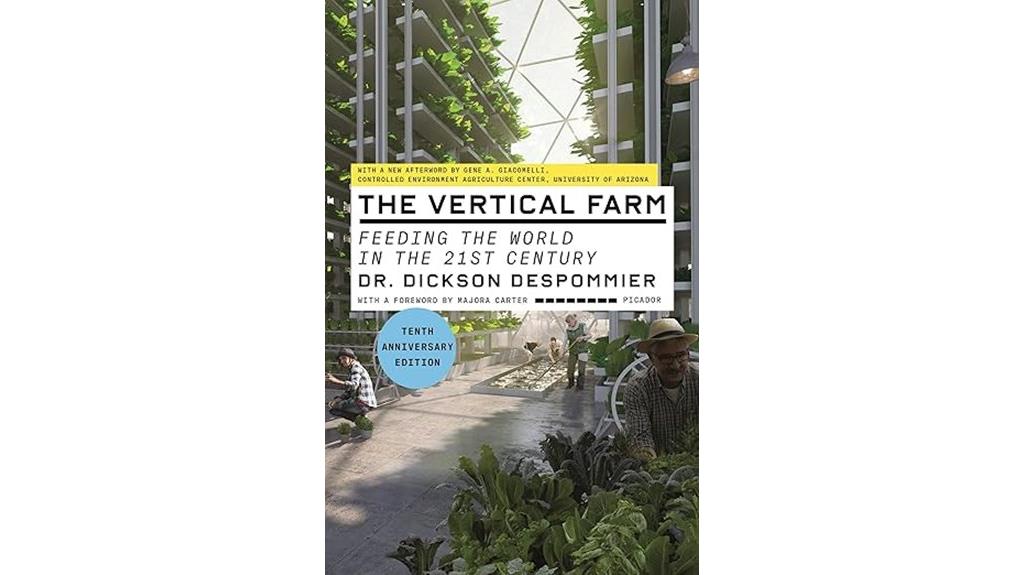
Readers who are passionate about sustainable agriculture and innovative urban solutions will find "The Vertical Farm: Feeding the World in the 21st Century (Tenth Anniversary Edition)" an invaluable resource. Dr. Despommier presents a compelling vision for addressing the challenges of traditional farming through vertical farming. While some critics argue the book leans on hypotheticals, I believe its visionary thinking inspires necessary change. The systems-level approach integrates various disciplines, showcasing both the threats of modern agriculture and practical solutions. Despite initial costs, the economic benefits make vertical farms a viable alternative, opening doors to a sustainable future for urban agriculture.
Best For: Individuals interested in sustainable agriculture, urban planning, and innovative environmental solutions.
Pros:
- Visionary Thinking: Inspires new ideas and solutions for sustainability in agriculture.
- Interdisciplinary Approach: Combines insights from various fields, offering a comprehensive understanding of agriculture's challenges and solutions.
- Economic Viability: Highlights potential long-term savings and efficiencies of vertical farming compared to traditional methods.
Cons:
- Hypothetical Language: Some critics argue that the reliance on "could" and "should" makes the arguments less concrete.
- Initial Costs: The high upfront investment in vertical farming technology may deter potential adopters.
- Implementation Details Lacking: Readers may desire more specific information on design and practical implementation of vertical farms.
4 Pack Potato Grow Bags 10 Gallon for Vegetables
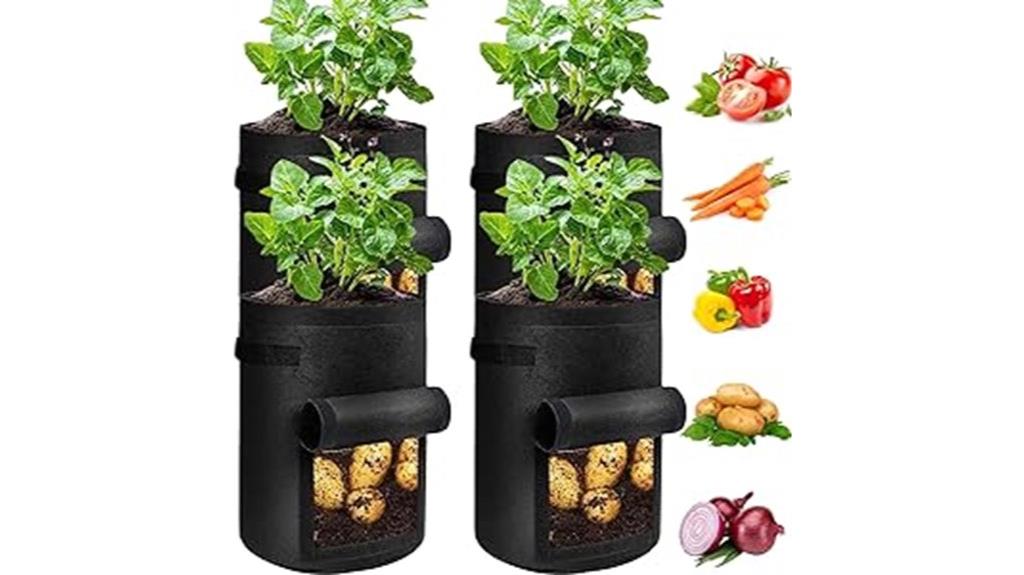
For anyone enthusiastic to grow their own vegetables, the JJGoo 4 Pack Potato Grow Bags offer an excellent solution with their 10-gallon capacity. Made from heavy-duty, BPA-free fabric, these bags promote healthy root growth with good airflow and excellent drainage, preventing root rot. The large harvest window makes access easy, and the durable design guarantees multiple seasons of use. I love how they retain moisture without waterlogging, ideal for vegetables like potatoes and carrots. While they can be heavy when full, the sturdy handles make transportation manageable. Overall, these bags are a fantastic investment for urban gardeners looking to maximize their yield.
Best For: Urban gardeners looking for durable and efficient solutions to grow vegetables like potatoes, onions, and carrots in limited space.
Pros:
- Heavy-duty non-woven fabric ensures durability and allows for multiple seasons of use.
- Large harvest window provides easy access to vegetables, simplifying the harvesting process.
- Excellent drainage and moisture retention promote healthy plant growth and prevent root rot.
Cons:
- Can be heavy and difficult to move when fully filled with soil and plants.
- Some users suggested the addition of a clear plastic cover over the harvest window for better protection.
- Limited capacity for larger yield needs, as each bag holds only 10 gallons.
Hydroponics Growing System for 30 Plants
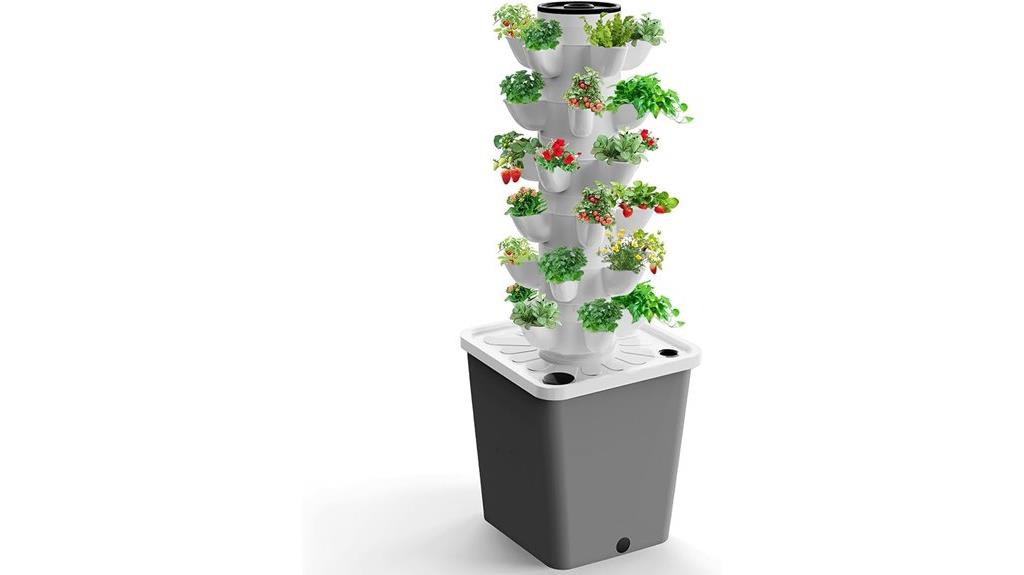
If you're passionate about indoor gardening but don't have much space, the Hydroponics Growing System by OvyNewzly is perfect for you. This compact 30-plants vertical tower system measures just 10 x 8 x 33 inches, making it a great fit for any corner. It utilizes a top-down water cycle, saving 95% more water while promoting oxygen flow to the roots. I love how easy it is to set up—no tools required! Plus, with recyclable materials, it's eco-friendly. While some users reported minor issues, the growth success I've experienced has been fantastic. Transform your indoor space into a green oasis with this system!
Best For: Indoor gardening enthusiasts looking for a compact, efficient hydroponic system to grow up to 30 plants.
Pros:
- Easy setup with no tools required, perfect for beginners.
- Saves 95% more water while enhancing oxygen flow to plant roots.
- Eco-friendly materials used in construction, promoting sustainability.
Cons:
- Mixed reviews regarding the clarity of the instruction manual and planting directions.
- Some users reported product defects that affected functionality.
- Limited support for troubleshooting issues as noted by some customers.
7 Pocket Hanging Planter for Outdoor Plants
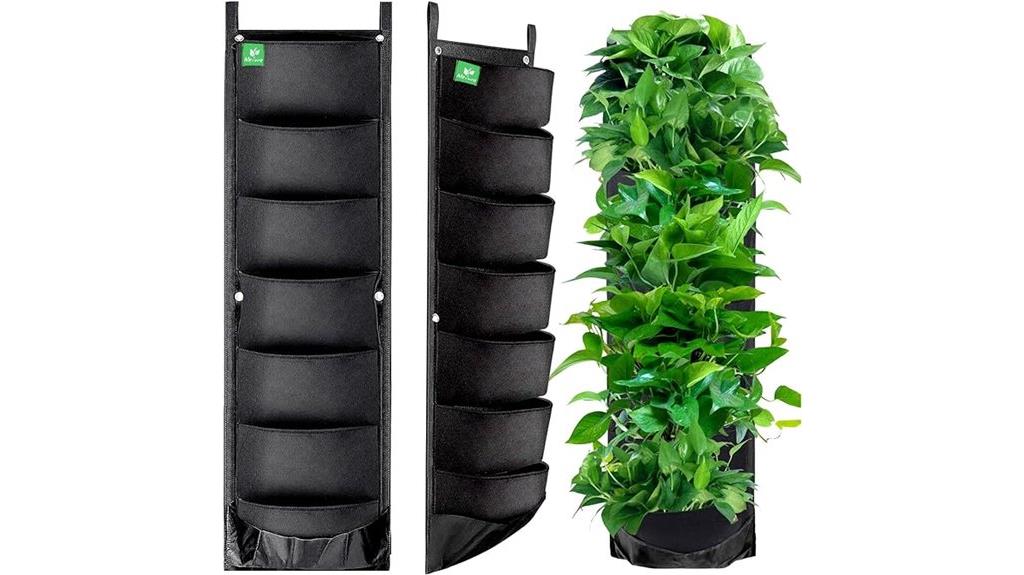
The MEIWO 7 Pocket Hanging Planter is a fantastic choice for anyone looking to maximize their outdoor gardening space without sacrificing style. I love how its durable felt fabric is both lightweight and portable, making it easy to set up on my balcony or fence. With seven pockets, I can grow a variety of plants, from herbs to flowers. Installation's a breeze with adjustable ties and built-in grommets. Plus, it serves as a stylish organizer for tools, too! While some users mention issues with water leakage, the overall aesthetic and space-saving benefits make it a worthy addition to any garden.
Best For: Gardening enthusiasts and individuals looking to enhance their outdoor spaces with a stylish and functional planter.
Pros:
- Lightweight and portable design allows for easy installation on various surfaces.
- Versatile pockets suitable for a wide range of plants, including herbs, flowers, and vegetables.
- Can double as an organizer for tools and essential items, maximizing space efficiency.
Cons:
- Some users report issues with water leakage, which may affect plant health.
- Pockets may be too shallow for certain plant types, limiting growth potential.
- Inconsistent sizing of hanging loops can lead to an asymmetrical appearance when mounted.
3 Pack Potato Grow Bags for Gardening
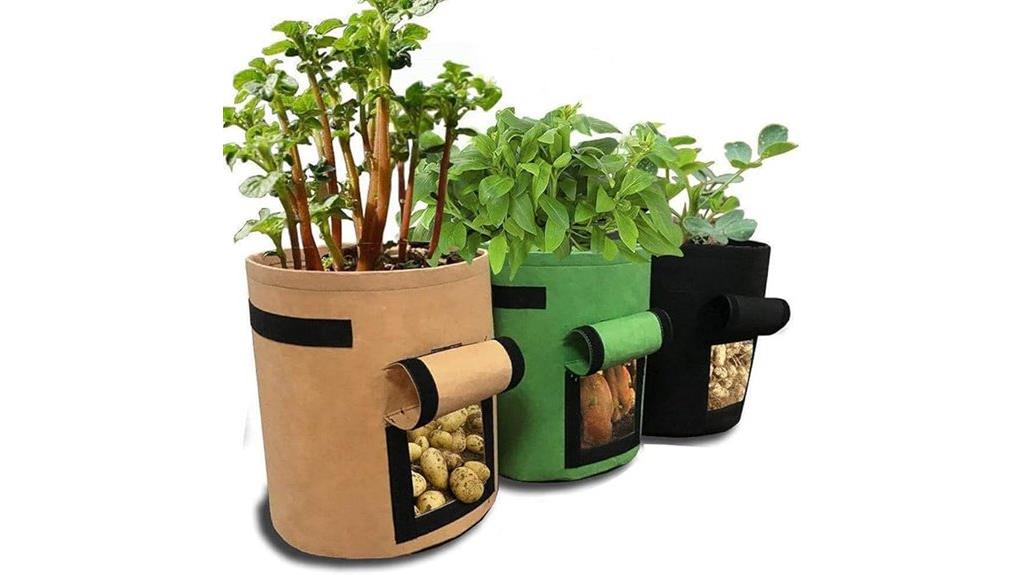
Looking to elevate your gardening game? The 3 Pack Potato Grow Bags from GEMGO are a fantastic choice! With a 7-gallon capacity, these durable, reusable bags come in black, brown, and green. Their breathable design promotes healthy root growth, while the observation window lets you check on your plants without any fuss. I love the access flap for easy harvesting—no more digging! These bags are perfect for potatoes, carrots, and other veggies, fitting seamlessly into patios or balconies. Plus, they're lightweight, making them a breeze to move around. Give them a try and watch your garden thrive!
Best For: Gardeners looking for a convenient and efficient way to grow vegetables in limited spaces like patios and balconies.
Pros:
- Durable, reusable fabric ensures long-lasting use for multiple growing seasons.
- Breathable design encourages healthy root development, leading to better plant growth.
- Convenient access flap and observation window simplify harvesting and monitoring plant maturity.
Cons:
- Limited size of 7 gallons may not be sufficient for larger vegetable varieties.
- Requires careful handling to avoid tearing the non-woven fabric material.
- Color options might not appeal to all gardeners' aesthetic preferences.
Hydroponics Vertical Garden Tower for Indoor Gardening

For urban dwellers and gardening enthusiasts with limited space, the Hydroponics Vertical Garden Tower is an ideal solution. This compact, six-layer tower lets me grow up to 30 different fruits and vegetables indoors or outdoors, making it perfect for my small apartment. With a 10-liter tank, the efficient top-down watering system guarantees my plants get the oxygen they need for faster growth. Assembly is a breeze—no tools required! Plus, its durable design promises longevity. I love watching my lettuce, strawberries, and cucumbers thrive right on my balcony. It's a game-changer for urban gardening!
Best For: Urban dwellers and gardening enthusiasts who want to maximize limited space for growing fresh fruits and vegetables indoors or outdoors.
Pros:
- Compact design allows for efficient use of small spaces like kitchens and balconies.
- Soilless hydroponic system promotes faster plant growth with efficient water use.
- Easy assembly without the need for tools, making it user-friendly for all skill levels.
Cons:
- Limited tank capacity of 10 liters may require frequent water refills for larger plants.
- Requires regular maintenance to ensure the pump is submerged and functioning properly.
- Initial investment may be higher compared to traditional soil gardening.
Vertical Hydroponics Garden Tower System Kit

With its compact design and ability to grow up to 30 plants simultaneously, the Vertical Hydroponics Garden Tower System Kit is perfect for urban dwellers who crave fresh produce but lack outdoor space. I love how its six layers and 30 holes allow me to cultivate a variety of fruits and vegetables right in my living room. The 10-liter water tank optimizes water use and enhances oxygen flow to the roots, boosting growth. Whether I've got a small balcony or a cozy kitchen, this system transforms any space into a vibrant garden, making home-grown, farm-quality veggies a reality.
Best For: Urban dwellers and gardening enthusiasts looking to grow fresh produce in limited indoor spaces.
Pros:
- Efficient space-saving design allows for simultaneous growth of up to 30 plants.
- Hydroponics system enhances growth by optimizing water use and increasing oxygen flow to roots.
- Versatile for indoor and outdoor use, making it suitable for various living environments.
Cons:
- Requires regular monitoring of water levels and nutrient solutions.
- Initial setup may be complex for beginners unfamiliar with hydroponics.
- Limited capacity for larger plants that may need more space as they grow.
27 Pack of 2-inch Net Pot Holders for Soilless Farming

Designed specifically for indoor gardeners, the 27 Pack of 2-inch Net Pot Holders makes soilless farming a breeze, especially in small spaces like apartments or bedrooms. These holders fit snugly on 4-inch PVC pipes, allowing me to grow a variety of plants like strawberries, tomatoes, and herbs without the mess of soil. I appreciate the clean setup and the premium materials that guarantee healthy root development. While some customers mention fit issues, I found that using rubber bands helps secure them better. Overall, they're a great addition to my vertical garden, optimizing space and simplifying my indoor gardening experience.
Best For: Indoor gardeners looking for space-saving solutions to cultivate plants in small areas without soil.
Pros:
- Simplifies soilless farming with easy-to-use hydroponic pods that prevent soil spillage.
- Ideal for growing a variety of plants including strawberries, tomatoes, and herbs in vertical gardens.
- Made from premium materials ensuring excellent air-to-water ratio for healthy root development.
Cons:
- Some customers report fit issues with the holders on PVC pipes.
- Mixed feedback on material quality, with a few users experiencing problems.
- May require adjustments, such as using rubber bands or drilling specific hole sizes for optimal fit.
Factors to Consider When Choosing Vertical Farming
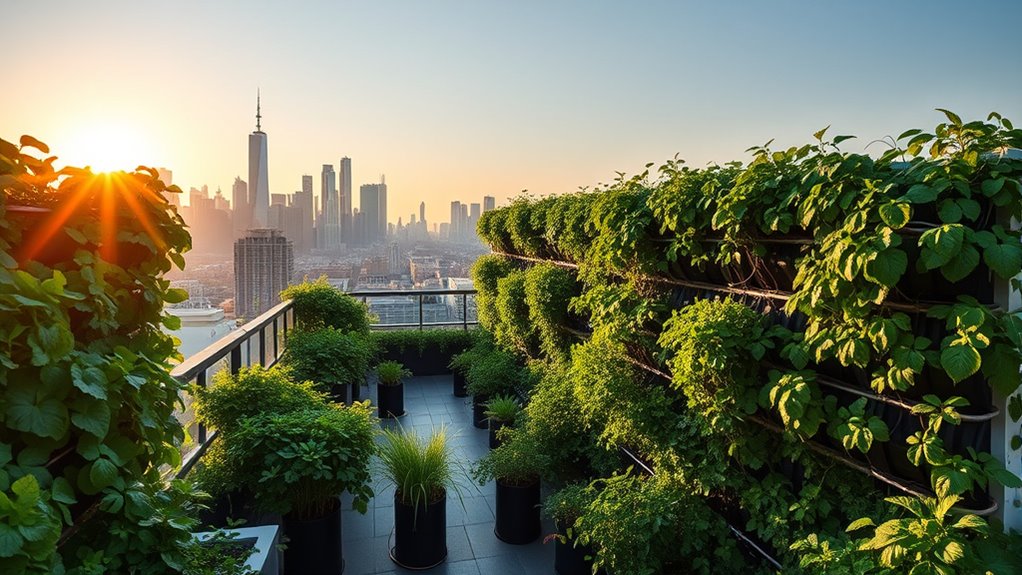
When I'm choosing a vertical farming system, I always consider space efficiency and how well it suits my growing environment. Plant compatibility is essential too, as not all crops thrive in vertical setups. Additionally, I think about water management, light sources, and nutrient delivery methods to guarantee a successful harvest.
Space Efficiency Requirements
Choosing vertical farming often hinges on space efficiency, as maximizing yield in limited areas is essential. I've found that some crops can yield up to 10 times more in vertical setups than in traditional methods, which is incredible for smaller spaces. For instance, I can cultivate plants in just 8 square feet of vertical space, compared to 24 square feet horizontally. This compact design is perfect for urban settings, like balconies or small gardens. Plus, vertical systems often use hydroponics or aeroponics, cutting water consumption by 90-95%. With higher plant density and optimized light exposure, I've noticed my plants grow up to 50% faster. It's a game changer for anyone looking to maximize productivity in tight spaces.
Plant Compatibility Considerations
Maximizing space efficiency in vertical farming goes hand in hand with selecting the right plants for the system. I've found that focusing on shallow-rooted varieties like herbs, strawberries, and lettuce works best in these setups. Deep-rooted plants, such as tomatoes or peppers, simply need more space than we can provide. Fast-growing plants thrive in hydroponic systems, often boosting growth rates by 30-50%, so I prioritize those to maximize yield. It's also essential to take into account light requirements; proper planning guarantees all levels get enough exposure. Finally, I always select disease-resistant and pest-tolerant plants. This choice reduces maintenance and increases success, allowing me to enjoy a flourishing vertical farm without constant worry.
Water Management Systems
As I explore vertical farming, effective water management systems stand out as an important component that can dramatically enhance efficiency. These systems can save an impressive 90-95% of water compared to traditional soil methods, which is a game-changer for sustainability. I've found that hydroponic systems, using top-down watering techniques, improve oxygen flow to the roots, leading to faster growth and higher yields. Automated watering systems simplify maintenance and guarantee consistent moisture levels, essential for plant health in soilless environments. Features like water level indicators help monitor and maintain appropriate water levels, preventing pump failures. Ultimately, a well-designed water management system not only distributes nutrients efficiently but also boosts productivity while minimizing waste in vertical farming setups.
Light Source Options
When it comes to selecting light sources for vertical farming, considering factors like spectrum and intensity is vital for achieving ideal plant growth. I prefer full-spectrum LED grow lights because they provide a balanced range of wavelengths, including rich red and warm white, which are essential for plant development. High-quality LEDs offer impressive photosynthetic photon efficacy (PPE), reaching up to 3.14 μmol/j per diode. I always check the light intensity; ideally, the photosynthetic photon flux density (PPFD) should hit 300 μmol/m²/s or more to guarantee effective photosynthesis. Dimmable lights give me flexibility in managing heat and intensity, adapting perfectly to different growth phases. Finally, I consider coverage; a 1000W LED typically covers 4x4ft or 4x6ft, assuring even light distribution.
Nutrient Delivery Methods
Choosing the right nutrient delivery method is crucial for maximizing plant growth in vertical farming. I recommend considering hydroponics, which uses a soilless medium to deliver nutrients directly to plant roots through water. This method can greatly boost growth rates and yields compared to traditional soil farming. Alternatively, aeroponics is an exciting option where plants are suspended in air and misted with nutrient-rich water, resulting in up to 50% faster growth due to increased oxygen exposure. It's also important to maintain a suitable pH level between 5.5 and 6.5 for effective nutrient absorption. Finally, automated nutrient delivery systems with smart technology can monitor and adjust nutrient levels in real-time, simplifying the process and improving plant health.
Maintenance and Care Needs
Maintaining a vertical farming system requires careful consideration of several key factors to secure ideal plant health and productivity. I regularly monitor water levels and nutrient solutions, especially since many hydroponic setups rely on automated irrigation systems. Cleaning pumps and reservoirs is vital to prevent algae growth and guarantee efficient water circulation. Depending on the plants I'm growing, I adjust light intensity and duration to cater to their specific growth stages. Regular pruning and harvesting are essential; they promote healthy growth and prevent overcrowding that can lead to reduced air circulation and increased disease risk. I also stay vigilant about pest control measures, as these environments can attract pests if not properly maintained.
Cost and Budget Constraints
Understanding the costs associated with vertical farming is essential for making informed decisions. The initial setup can vary greatly; while some hydroponic systems might cost just a few hundred dollars, more complex systems can exceed thousands. Don't forget the ongoing operational expenses—energy, water, and nutrient supplies can add up, especially with automated systems. However, vertical farming's space efficiency can lead to higher yields in smaller areas, potentially lowering land costs compared to traditional farming. Budget constraints might steer you toward more cost-effective materials and technologies, though they may require extra labor. Finally, consider the potential return on investment; higher upfront costs can lead to greater productivity and reduced long-term expenses if managed effectively.
Frequently Asked Questions
What Are the Initial Costs of Setting up Vertical Farming?
When I looked into setting up vertical farming, I found the initial costs can vary widely. I had to take into account expenses like equipment, seeds, and energy. Depending on the scale, I saw figures ranging from a few thousand to hundreds of thousands of dollars. It's essential to factor in ongoing operational costs too. Planning my budget carefully helped me understand what I needed to invest for a successful start.
How Much Space Do I Need for Vertical Farming Systems?
Imagine planting a garden in the sky, where every inch counts. When I set up my vertical farming system, I realized that even a small space can yield a bountiful harvest. Generally, I recommend at least 100 square feet for a starter system, but you can optimize any area—whether it's a balcony or an unused corner. It's amazing how creativity and smart design can transform limited space into a thriving garden!
What Crops Are Best Suited for Vertical Farming?
When I think about what crops are best suited for vertical farming, I often lean towards leafy greens like lettuce and spinach. They thrive in smaller spaces and grow quickly. Herbs, such as basil and mint, also do well and add value to any urban garden. I've found that strawberries can be surprisingly successful too, offering both beauty and delicious fruit. Ultimately, it's about what fits your taste and space!
How Do I Maintain Optimal Conditions in Vertical Farms?
Maintaining ideal conditions in my vertical farm is essential for success. I regularly monitor temperature and humidity levels, ensuring they stay within the perfect range for my crops. I also check light intensity, adjusting as needed to promote healthy growth. Additionally, I pay close attention to water and nutrient delivery, using a reliable system to keep everything balanced. By staying proactive and attentive, I can create a thriving environment for my plants.
Can I Integrate Vertical Farming With Existing Urban Spaces?
Integrating vertical farming into existing urban spaces is like turning a concrete jungle into a lush paradise! I've discovered that rooftops, vacant lots, and even community gardens can host vertical farms. With the right planning, you can seamlessly blend these farms into the landscape. By utilizing innovative systems and local resources, I've seen how we can transform our cities into sustainable food hubs, making fresh produce accessible right where it's needed most.
Conclusion
In the world of urban agriculture, finding the right vertical farming solution can feel overwhelming, but it's all about what fits your needs. Whether you're drawn to the sleek MARS HYDRO lights or the efficiency of a Garden Tower, each option offers a unique way to grow. Coincidentally, as you explore these tools, you'll discover that transforming your space isn't just about plants; it's about cultivating a lifestyle. So, let's elevate our gardens and embrace this green revolution together!
